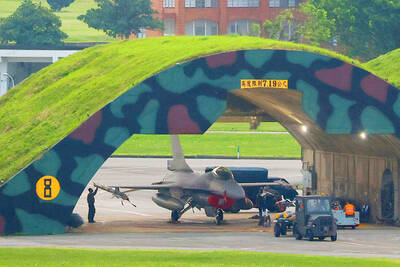A new longer-range ballistic missile allegedly deployed by China and the introduction of multiple warhead capabilities could render obsolete Taiwan’s most advanced missile interceptors, analysts said yesterday.
National Security Bureau (NSB) Director Tsai Der-sheng (蔡得勝) told the legislature on Wednesday that China had recently begun deploying Dong Feng-16 (DF-16) ballistic missiles with a range of between 800km and 1,000km, and that some were targeting Taiwan.
One US expert with years of experience monitoring developments in China’s missile arsenal told the Taipei Times that while literature on the DF-16 was scarce, the fact that a different designation had been referenced implied that the system was sufficiently different from existing missiles.

Photo: China Military Online
Another, Rick Fisher, a senior fellow at the International Assessment and Strategy Center in Washington, said chances the DF-16 is the “real deal” were high, adding that the new system would likely incorporate advances in solid rocket fuel, guidance and warhead design. He admitted this was the first time he had seen references to the DF-16 designation.
Alarmingly, the faster re-entry of a longer-range ballistic missile such as the DF-16 would greatly reduce the effectiveness of Taiwan’s PAC-3 missile interceptors that were acquired at great cost from the US and which are still in the process of being deployed.
The longer the range of a ballistic missile, the higher it must climb to reach its target and the higher it climbs, the more time it takes for it to fall to the ground, giving gravity more time to accelerate the descent of the warhead at a rate of about 9.8m per second squared.
“All the PAC-3s are not yet in the field, but when they are, they can potentially be defeated by the faster 1,000km DF-16,” Fisher said.
In addition, new long-range missiles would give China’s leadership the ability to make “peace gestures,” such as withdrawing older DF-15s, without any substantial reduction of military pressure on Taiwan, he said.
The removal of some missiles targeting Taiwan has been touted as a potential “goodwill” gesture by Beijing to help President Ma Ying-jeou (馬英九) get re-elected next year.
Ballistic missiles with a range such as that attributed to the DF-16 could be deployed at the Second Artillery’s 52 Base in Anhui Province and target Taiwan as well as US bases in the region, such as Okinawa and Guam.
According to a study by the Project 2049 Institute, 52 Base oversees five short-range ballistic missile (SRBM) brigades and as many as three medium-range ballistic missile brigades. It remains unclear whether 52 Base is being equipped with a new brigade for the DF-16 or whether they would replace older SRBMs.
Wendell Minnick, Asia bureau chief for Defense News, was more skeptical on the DF-16 representing a new type of missile, saying it was likely a variant of the existing DF-15, which has a range of about 600km.
“Honestly, I can’t see how all the US analysts missed it, if it is ‘deployed,’” Minnick said. “I suspect he [Tsai] is saying the DF-15 extended range is the new ‘DF-16,’ but the lack of details during his testimony annoys me to no end.”
“It’s possible they [the government] are trying to scare the US into releasing new F-16 fighters and submarines,” Minnick said.
During his presentation, Tsai also said that most of China’s missiles now had multiple warheads capable of hitting different targets, such as radar sites and planes at airports.
While it is known that the DF-21 “aircraft carrier killer” — which Tsai said was also recently deployed — has multiple warheads, news that smaller missiles in the Chinese arsenal have multiple reentry vehicles (MRVs) would be a worrying development, Fisher said.
“PAC-3s can only handle one incoming missile target, not [several] MRVs,” he said, adding that the US had recently canceled a missile defense program intended to give missile interceptors the ability to take out MRVs.

MISINFORMATION: The generated content tends to adopt China’s official stance, such as ‘Taiwan is currently governed by the Chinese central government,’ the NSB said Five China-developed artificial intelligence (AI) language models exhibit cybersecurity risks and content biases, an inspection conducted by the National Security Bureau (NSB) showed. The five AI tools are: DeepSeek, Doubao (豆包), Yiyan (文心一言), Tongyi (通義千問) and Yuanbao (騰訊元寶), the bureau said, advising people to remain vigilant to protect personal data privacy and corporate business secrets. The NSB said it, in accordance with the National Intelligence Services Act (國家情報工作法), has reviewed international cybersecurity reports and intelligence, and coordinated with the Ministry of Justice Investigation Bureau and the National Police Agency’s Criminal Investigation Bureau to conduct an inspection of China-made AI language

BOOST IN CONFIDENCE: The sale sends a clear message of support for Taiwan and dispels rumors that US President Donald Trump ‘sold out’ the nation, an expert said The US government on Thursday announced a possible sale to Taiwan of fighter jet parts, which was estimated to cost about US$330 million, in a move that an expert said “sends a clear message of support for Taiwan” amid fears that Washington might be wavering in its attitude toward Taipei. It was the first announcement of an arms sale to Taiwan since US President Donald Trump returned to the White House earlier this year. The proposed package includes non-standard components, spare and repair parts, consumables and accessories, as well repair and return support for the F-16, C-130 and Indigenous Defense Fighter aircraft,

CHECKING BOUNDARIES: China wants to disrupt solidarity among democracies and test their red lines, but it is instead pushing nations to become more united, an expert said The US Department of State on Friday expressed deep concern over a Chinese public security agency’s investigation into Legislator Puma Shen (沈伯洋) for “secession.” “China’s actions threaten free speech and erode norms that have underpinned the cross-strait ‘status quo’ for decades,” a US Department of State spokesperson said. The Chongqing Municipal Public Security Bureau late last month listed Shen as “wanted” and launched an investigation into alleged “secession-related” criminal activities, including his founding of the Kuma Academy, a civil defense organization that prepares people for an invasion by China. The spokesperson said that the US was “deeply concerned” about the bureau investigating Shen

‘TROUBLEMAKER’: Most countries believe that it is China — rather than Taiwan — that is undermining regional peace and stability with its coercive tactics, the president said China should restrain itself and refrain from being a troublemaker that sabotages peace and stability in the Indo-Pacific region, President William Lai (賴清德) said yesterday. Lai made the remarks after China Coast Guard vessels sailed into disputed waters off the Senkaku Islands — known as the Diaoyutai Islands (釣魚台) in Taiwan — following a remark Japanese Prime Minister Sanae Takaichi made regarding Taiwan. Takaichi during a parliamentary session on Nov. 7 said that a “Taiwan contingency” involving a Chinese naval blockade could qualify as a “survival-threatening situation” for Japan, and trigger Tokyo’s deployment of its military for defense. Asked about the escalating tensions